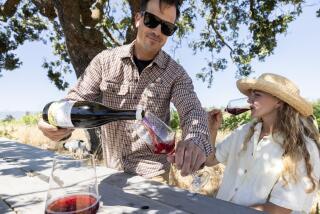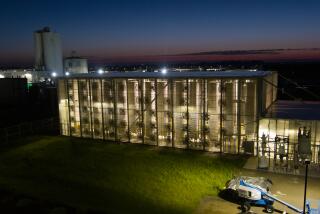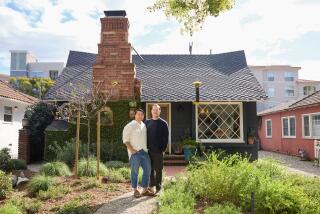No Place Like Dome for Winter Growing Season : The Late Buckminster Fuller Inspired New Horticulture-Aquaculture Project
- Share via
OLD SNOWMASS, Colo. — Just look at what it does. It gives you more growing space than the land it occupies. It creates a tropical environment at 7,100 feet in the Rockies with no energy used--year-round. And it can be very cheaply built with hand tools.”
--Energy consultant Amory Lovins, director of the Rocky Mountain Institute, describing the “biodome” at Windstar Foundation, a half mile from his home.
There’s already snow on the ground here, and right next to it you can find cantaloupes ripening on the vine, catfish who think they’re swimming in Montego Bay, geraniums in full bloom and dozens of other species in various stages of their growth cycles.
Though the traditional Rocky Mountain growing season extends only from about July through August, these crops are defying their environment and thriving at the icy altitude of 7,100 feet inside a “biodome,” an innovative approach to horticulture and aquaculture inspired by the late Buckminster Fuller.
Doing More With Less
Fuller, whose geodesic dome is the best-known artifact of his do-more-with-less philosophy, visited John Denver’s Windstar Foundation here in 1980, 1981 and 1982. And out of those visits came plans to create a solar greenhouse/fish farm using his dome technology, which is said to provide the greatest amount of interior volume using the least amount of exterior surface area.
Exterior surface area being roughly equivalent to heat-loss area, that’s a big deal in locations where people have heating bills like those popular in the Rockies. Here in the land known for its posh ski resorts and back-to-nature enthusiasts, heating even a small, non-solar greenhouse is considered financially unfeasible.
But the biodome project, designed by solar energy expert and former high school science teacher John Katzenberger, seeks to reverse all that. It has married the best theories of horticulture with the latest in aquaculture in an ecosystem designed to let nature protect the couple’s offspring from one of the harshest climates in the world.
High-Tech Victory Garden
Last fall, about a year after Fuller’s death, the 25-foot prototype biodome started producing zucchini, scallions, bluegill, watercress, beets, New Zealand spinach, spearmint, snap dragons, pomegranates and much, much more. About the only thing missing from this highly personal, high-tech victory garden is a couple of palm trees.
Constructed of wood recycled from a dome built at Windstar during one of Fuller’s visits, the biodome is powered almost exclusively by active and passive solar energy; its “skin” consists of inflatable pillows made of heat-mirroring polyester film, which permits the maximum amount of sunlight, releases the least amount of heat and holds up under massive snowfalls.
According to Katzenberger, a 5,000-gallon fish tank on the ground floor of the biodome stores heat from the sun and gradually disperses it to create a distinctly tropical climate by day and a somewhat cooler, but still adequate temperature at night.
Until it gets down to 20 below zero, that is. Or worse. Last year, during the biodome’s inaugural winter, the thermal mass created by the sun and the fish tank was quite cozy until the mercury hit 20 below. Then for 10 days, says Katzenberger, it was necessary to burn a few logs inside the dome to keep the crops from freezing while temperatures plummeted as far as 36 below. (Everything survived except for one basil plant.)
The first year results, in terms of food harvested, amounted to 470 pounds of produce, about 2 3/4 pounds per square foot of growing space. No fish have been harvested yet but they’ve been growing and reproducing, as have the biodome’s resident pair of Zebra finches. The birds were installed as an experiment in pest control (in addition to conventional means such as ladybugs) because no pesticides or herbicides are used in the structure.
When a larger, 50-foot biodome (now under construction at Windstar with four floors planned for the inside) is completed, Katzenberger estimates that its annual produce will weigh in at about 4,000 pounds.
He further calculates the cost of materials for the 25-foot biodome to be about $5,000, and $30,000 for the 50-foot version.
Energy-Efficient Features
But such estimates may be misleading. These people, recyclers par excellence, are masters at doing more with less. Windstar, a nonprofit organization “devoted to education about, and demonstration of the potential of alternative and renewable technologies ranging from energy to food production,” was founded by John Denver and Thomas Crum in 1976. Its 945 acres are dotted with such energy-efficient features as a wind machine, a solar shower, a solar composting toilet, and tepee frames (where summer guests frequently stay).
Asked how much has been spent so far on the 25-foot biodome, Katzenberger replies that salaries (for several individuals) and materials since 1983 have amounted to about $100,000. Then he smiles and says, “We’re very frugal.”
In about a year Katzenberger expects Windstar may be offering biodome kits to people willing to work with the foundation on research. Already there have been many inquiries, one of which came from members of the Peace Corps.
Windstar’s biodome is not the first such experiment in expanding the possibilities in growing food. As Katzenberger is quick to point out, the project has borrowed heavily on work of a similar nature done at the New Alchemy Institute in Falmouth, Mass., where, according to education director Earl Barnhart, a solar-powered dome raising both plants and fish has been in operation for about three years, producing food in temperatures as low as zero degrees.
What makes Windstar’s biodome unique, however, is its demonstration that food and fish can be raised in an extremely cold climate.
Which may account for the choice of the next major phase of the project’s research and development. Having shown what can be done in the mountains, Windstar will next attempt to prove that a similar miracle can occur in the opposite extreme climate: the desert. Already, Katzenberger has locations in Nevada.
How can the same structure and systems be used for heating and cooling purposes?
As Katzenberger explains, the dome will keep moisture from rapidly evaporating in the hot sun; water in the fish tank can be cooled at night by the desert sky and air in the dome will be stabilized by the water in the fish tank.
Other variables such as the fan and irrigation systems can also be manipulated.
It is this latter phase of research and development of desert biodomes that could be a most powerful demonstration of Fuller’s dictum to “think globally and act locally.” If successful, the desert biodomes could have a profound effect on areas of the world struck by drought and famine.
Because it is a biologically protected area, the biodome is considered ideal for growing food in marginal growing areas: places where soil has been abused and lost its ability to produce food or places where the soil is loose, sandy and easily blown away.
As John Denver says, “When I was in Africa, I had a vision of biodomes across the landscape.”
Denver is clearly pleased with the results of Windstar’s biodome project, especially the fact that it provides food while using minimal amounts of natural resources. But he’s not entirely thrilled with the way the biodome works.
“It’s not a natural environment or a complete ecosystem,” Denver observes. “It’s excludes the wind and the rain. I would like to see it incorporate more of the natural elements.”
In addition to meeting those goals, Katzenberger wants to improve the biodome’s design to make it simpler and cheaper. “There are major disciplines of study going onfrom structural engineering and architecture to the physics of heat storage and transfer. Then there’s a complex realm of the different biological disciplines. You could spend your life working on all the different interrelationships in the dome. And at the same you could just grow food and have a lot of fun. It’s very simple and it’s very complex.”
Now or in the future, however, Katzenberger insists that people won’t have to be blue-ribbon gardeners to be successful with biodomes.
“I think that anybody could do it who’s had at least a year’s experience in their own backyard kind of garden. It would require that you have a dedication to learning more about the ecosystem that you’re setting up and certainly, raising the fish would add a new dimension. There’s a definite learning curve with aquaculture.”
Might the biodome also provide some lessons in what is known as “sustainable agriculture” for the farm crisis currently facing the United States and other nations? A Windstar brochure on the biodome states, “Backyard gardeners, small family farmers, community groups and specialty commercial growers can adapt the biodome design to meet their food-growing needs” but it says nothing about large commercial growers.
Katzenberger’s comments further clarify that Windstar has no intention of preaching about energy-efficient, sustainable agriculture to big farm interests.
“It (the biodome) is not intended to replace appropriate agricultural systems, but only to augment them,” Katzenberger says. “I don’t see the biodome as being the answer to that. It’s one small piece of the puzzle, one of the answers.”
Windstar’s neighbor from the Rocky Mountain Institute (a nonprofit research and education foundation also exploring environmental issues) is slightly less modest about the achievements and potential impact of the biodome.
Says Institute founder Amory Lovins: “I think the biodome is a prototype of passive, climatically responsive structures that make it possible for anyone--including farmers--to grow high-value crops year-round in even the harshest climates and do so very cheaply. As such, it’s a small part of the solution to the farm crisis.”
Lovins also notes that one of the greatest energy savings associated with the biodome occurs in the transportation of food rather than in the production of it.
“It’s estimated that the average molecule of food travels about 1,300 miles before somebody eats it,” he says. “This may tell you something about why it tastes like it does. Biodomes could go a long way toward making food better tasting, more nutritious and more resilient.”
Much of that remains to be seen. But one point can be settled now. Produce from the biodome is apparently about as tasty as fruits and vegetables can get. At least in the estimation of one junk-food connoisseur. The woman was offered a cherry tomato fresh from the fish water-fed vine and declared it to be the sort of thing that could give salads a good name.






